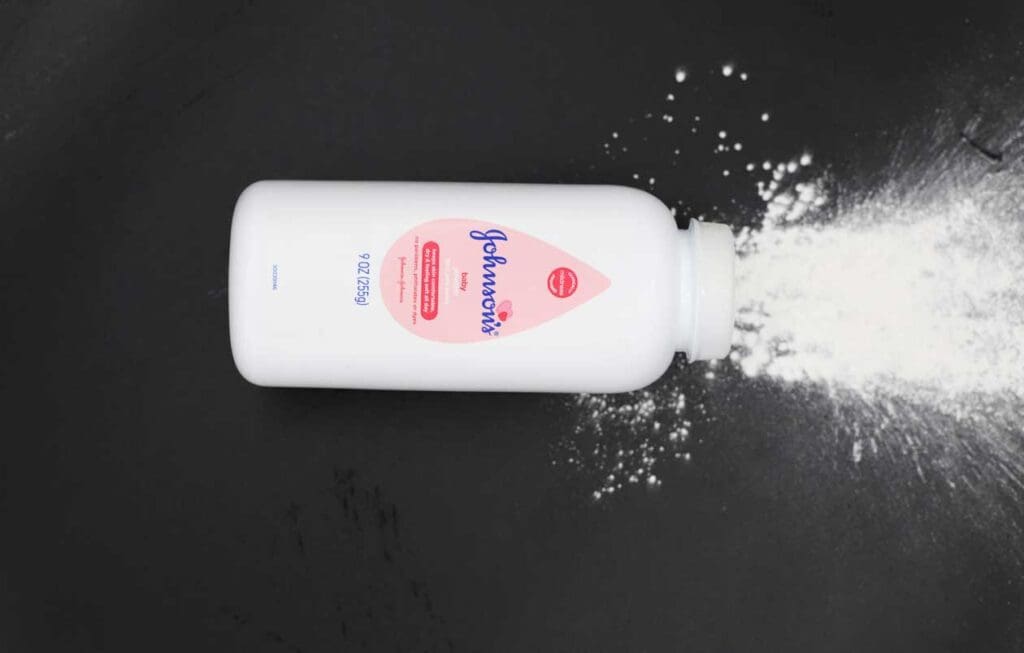Talc, mined from the rock deposits in the earth’s crust with a chemical formula of Mg3Si4O10(OH)2, is an ingredient used in food additives, industrial products, and cosmetics – baby powder, face powder, body powder, foundation, eye shadow, and blush.
The crushed, dried, and milled talc powder prevents caking, absorbs moisture, lubricates, and adds softness and gloss to products.
Studies link talcum powder to health and safety issues as it often contains asbestos, a carcinogen. Frequent users of talcum powder have questioned both Johnson & Johnson, as well as the FDA about the overall safety and impact of using a powder frequently. The rise of lawsuits has led to J&J settling over 38,000 talcum powder lawsuits.
How do you know if you’re eligible to file a talcum powder lawsuit? The following criteria make you eligible to file a baby powder lawsuit.
Suppose your prolonged use of Johnson and Johnson talcum powder caused you ovarian cancer or mesothelioma, and you are within your state’s statute of limitations. If that is the case, you are eligible to file a talc lawsuit against Johnson and Johnson. These criteria are discussed below.
Talcum Powder Lawsuit Criterion #1: Talcum Powder Product Use and Duration
You can only file a talcum powder lawsuit if you have used Johnson and Johnson Baby Powder or Shower to Shower for an ample amount of time and frequency. You should have used Johnson talc products or baby powder daily for many years for this to apply.
How did you use Johnson baby powder? General use, whether genital powder use or just an indirect exposure to asbestos present in talc particles, enables asbestos to enter your body, causing inflammation that can lead to cancer.
How often and how long you have used Johnson baby powder and other talc products can significantly contribute to your eligibility to file a talcum powder lawsuit.
Talcum Powder Lawsuit Criterion #2: Specific Cancer Diagnoses due to Talcum Powder Product Use
You can file a talcum powder lawsuit if you have been diagnosed with ovarian cancer or mesothelioma from the use of talc-based products. Studies show that talcum powder exposure increases the risk of ovarian cancer and mesothelioma.
But what are ovarian cancer and mesothelioma? And how does talcum powder cause these types of cancer?
Ovarian Cancer
Ovarian Cancer and Its Symptoms
Ovarian cancer is a disease that affects the ovaries. Its symptoms are bloating, pelvic or abdominal pain, eating difficulty or feeling full quickly, and urinary symptoms based on urgency and frequency. These symptoms are often mistaken for other common diseases.
Most symptoms appear in the advanced stages of ovarian cancer and rarely appear in the early stages.
Types of Ovarian Cancer
The types of ovarian cancer are named after the types of cells they come from:
- epithelial cells
- germ cells
- stromal cells
Epithelial ovarian cancer comes from the epithelium, the surface of the ovary. The most common type of ovarian cancer includes fallopian tube cancer and primary peritoneal cancer. Endometrioid ovarian cancer, allegedly caused by talcum powders, is a type of epithelial ovarian cancer. Germ cell ovarian cancer is rare and comes from the reproductive cell. In contrast, stromal cell ovarian cancer that comes from the connective cells is the rarest type of cancer.
Factors that Increase the Risk of Ovarian Cancer
Your risks of ovarian cancer are higher if:
- you are 63 years or older
- you are overweight or obese
- you had children after age 35 or never had a full-term pregnancy
- you take hormone therapy after menopause
- you have a family history of ovarian, breast, or colorectal cancer
- you have a family cancer syndrome like HBOC, HNPCC, Peutz-Jeghers syndrome, or MUTYH-associated polyposis
- you used a fertility treatment
- you had breast cancer
- you smoke.
Talcum Powder and Asbestos Contamination
Talc is mined in the same area as asbestos. Asbestos particles mix with talc, leading to asbestos-contaminated talcum powder when mined. It is the responsibility of cosmetics companies to research and choose their mining sites carefully while constantly examining to prevent their talc product from asbestos contamination.
The US Department of Health and Human Services, the US Environmental Protection Agency (EPA), and the International Agency for Research on Cancer (IARC) listed asbestos to be carcinogenic (cancer-causing) to humans. It is known to cause lung cancer, larynx cancer, mesothelioma, and ovarian cancer.
Studies on Talcum Powder and Ovarian Cancer
It is important to emphasize that a direct link between talcum powder and cancer is still unproven, but considerable research has been conducted in that area. These studies have repeatedly mixed findings. Some report a slight increase in risk factors, while others report no increase.
The study, “The Association Between Talc Use and Ovarian Cancer: A Retrospective Case-Control Study in Two US States,” in 2016, claimed that there is a significant relationship between perineal talcum powder use and epithelial ovarian cancer. The researchers asked about the talcum use of 2,014 ovarian cancer patients (cases) and 2,100 healthy women (controls). Women who dust their genital area, underwear, sanitary napkins, and tampons with talcum powder products regularly are 33% more prone to ovarian cancer. These women said they used Johnson and Johnson Baby Powder or Shower to Shower Body Powder.
Another study, “Perineal Talc Use and Ovarian Cancer: A Systematic Review and Meta-Analysis,” in 2018 found an association between perineal talc use and ovarian cancer.
Critics say that Johnson and Johnson talc-based products are specifically marketed to African American women. A study of African American women conducted by Joellen M. Schildkraut claimed that women who used talcum powder in their genital area had a 44% increased risk for ovarian cancer.
In 2019, the US Food and Drug Administration (FDA) tested a Johnson and Johnson baby powder bottle and found it positive for asbestos. From then on, the FDA gathered its experts from eight different federal agencies and developed recommendations to standardize the testing of talc products for asbestos. However, whether or not the products contain asbestos, they deemed the standardized testing of talc products for asbestos irrelevant. This is because talc and asbestos look similar in the microscopic photos. In addition, they believe asbestos and similar minerals, like talc, can cause “similar pathologic outcomes.”
Therefore, talc, even without the presence of asbestos, can cause health problems. Thus, the application of talcum powder products to the genitals enables talc particles to enter the ovaries and causes inflammation and, eventually, may cause ovarian cancer.
On the other hand, studies in 1976 and 2016 did not find any significant association between talcum powder use in their genitals and ovarian cancer. But scientists and researchers continue to research more about the topic.
Some studies claimed a slight increase in ovarian cancer in women who used talc-based powders in their genitals. Yet, many consider these studies limited, and their findings are “unusually consistent.” In addition, they rightfully believe case-control studies can be biased, as such studies depend on a person’s memory from many years earlier.
Even the prospective cohort studies that do not have the same type of potential bias did not find a significant increase in the overall ovarian cancer risk.
Mesothelioma
Mesothelioma is the cancer of mesothelial cells—the membranes covering the lungs and chest cavity (pleura), the abdominal cavity (peritoneum), and the internal organs. It is caused by exposure to asbestos.
Mesothelioma is a rare cancer affecting only about 3,000 cases are diagnosed annually compared to more than 200,000 annual lung cancer diagnoses.
Asbestos particles, when inhaled, penetrate the pleura and cause irritation that leads to cancer. People who work around asbestos, used in insulation, construction, automotive plants, and other industries, have the most significant risk of acquiring mesothelioma.
A 2014 study claims that only specific talcum powder brands contain asbestos fibers. As a result, they can be released into the air and inhaled during typical talcum powder application.
Some studies also associate mesothelioma with prolonged use and exposure to talc-based products contaminated with asbestos. The signs appear only after 30-40 years of asbestos exposure.
Difficulty in breathing, chest pain, abdominal pain, and fatigue are the symptoms of mesothelioma. Imaging scans, blood tests, and biopsy procedures are necessary to diagnose the disease.
Most studies present mesothelioma cases among talc miners, millers, and metal casting workers using asbestos-contaminated talc. Only 33 people in the 2019 study reported acquiring mesothelioma due to asbestos-contaminated talcum powder.
Several counts of Johnson and Johnson talcum powder lawsuits plus the finding of asbestos in samples tested by the FDA, the company recalled 33,000 bottles of Johnson’s Baby Powder in 2019. In addition, due to plummeting sales, the company stopped selling talc-based baby powders in the US and Canada. Yet, Johnson and Johnson remains firm in defending Johnson’s talc-based product and its safety.
Talcum Powder Lawsuit Criterion #3: Statute of Limitations
Time is of the essence in filing your Johnson and Johnson talcum powder lawsuit. You have to be aware of your state’s statute of limitations regarding personal injuries and wrongful death on product liability for your talc litigation.
What is a statute of limitations?
Once diagnosed with ovarian cancer or mesothelioma due to talc products, a law is in place to give you a limited time frame to initiate talc litigation against the talcum powder company. This law is the statute of limitations. However, the statute’s duration that allows you to file your talcum powder lawsuit differs from one state to another.
Complainants must carry out legal actions before this period ends.
Statute of Limitations for Talcum Powder Lawsuits
The statute of limitations safeguards cases so that they do not take years and are filed in appropriate courts. It ensures legal actions happen within a reasonable timeline.
The statute also ensures that defendants (say, Johnsons and Johnson) will be well-informed and ready for the talcum powder lawsuit since the plaintiff filed a lawsuit on time.
The progress duration of the powder lawsuits varies by disease. Although rules can slightly change, you should not wait to file your talcum powder cancer lawsuit.
The following are the statute of limitations of some states for personal injury.
1 Year: California, Tennessee
2 Years: Illinois, New Jersey, Ohio, Pennsylvania, Texas
3 Years: Oregon, New York
4 Years: Florida
The Discovery Rule, Statute of Repose, and Talcum Powder Lawsuits
Discovery Rule
Ovarian cancer and mesothelioma have a long latency period and symptoms can appear 20 to 50 years after exposure. Since an ovarian cancer diagnosis is determined many years after exposure to toxic talcum products, many states utilize the “discovery rule” primarily for personal injury cases. The statute of limitations starts from the plaintiff’s diagnosis (the time of discovery) of ovarian cancer or mesothelioma.
Statute of Repose
Time is relevant for filing your talcum powder lawsuit because the statute protects the defendants from long-term product liability.
Statute of repose, or nonclaim statute, is a statute that bars all the plaintiff’s legal rights if they are not acted upon in the specified deadline. Therefore, an attorney needs to examine the statute of repose of the appropriate state where you filed the talcum powder case. Failure to understand the said repose will deny the plaintiff’s ability to recover all the talcum powder claims.
State Rules for Talcum Powder Lawsuit
An attorney will guide you in which state to file a talcum powder lawsuit as it is essential for the result of the claim.
The following serve as guides for talcum powder cancer patients to file a lawsuit or claim.
- The state of residence or where the patient lived earlier
- Type of claim: personal injury, wrongful death, or trust fund (statute of limitations varies)
- The geographical location of exposure (the best place to file) and the start and end period of exposure
- The company’s site or headquarters (state)
- The severity of the cancer diagnosis
Time is of the essence when you file a lawsuit for developing ovarian cancer or mesothelioma due to talc-containing products. Every talcum powder cancer case is different. Specific factors like those mentioned above need thorough discussion and consultation.
Having an experienced attorney beside you along the way will be very beneficial. Talcum powder cancer attorneys will guide you through all your eligibility concerns for your talcum powder case. In addition, they will help you file for a just remuneration for the talc products’ damages caused you.
Harmful BRCA1 and BRCA2 Genes: Ineligible for Talcum Powder Lawsuits
BRCA stands for BReast CAncer. Everyone has two copies of BRCA gene 1 (BRCA1) and two copies of BRCA gene 2 (BRCA2). Each copy is inherited from each parent. They primarily produce proteins to help repair damaged DNA, protecting an individual from certain cancers.
However, they are also called tumor suppressor genes. Cancer develops when specific changes(called harmful variants or pathogenic mutations) develop. If you inherit pathogenic mutations in one of these genes, you will have an increased risk of cancers, especially ovarian and breast cancers.
Having inherited a harmful variant of BRCA1 or BRCA2 makes you or your loved one ineligible to file a talcum powder lawsuit, as those genes might have caused your ovarian cancer or mesothelioma. Talcum powder or talc-containing products may not be the cause of your cancer.
Time Is of the Essence
Talcum Powder Lawsuit Update
In May 2018, J&J went to trial in St. Lois. The hearing lasted for six weeks, with testimonies from more than 30 witnesses. The jury found J&J liable for all claims of 22 victims. The jury granted each plaintiff $25 million (totaling $550 million) in compensatory damages and a massive amount of $4.14 billion in punitive punishment.
As J&J appealed the 2018 trial verdict, the appellate court in June 2020 reduced the punitive damages to $1.6 billion and the compensatory damages to $500 million. As a result, total liabilities were reduced from $4.7 billion to $2.1 billion.
Your Case Is Unique
As long as you and your attorneys prove that you have mesothelioma or an ovarian cancer diagnosis because of your frequent use of talcum-based products and you file your talcum powder lawsuit within the set statute of limitation, you will be compensated for what you have lost and for the injuries incurred.
If this seems complicated, you may request a free case review.
Be updated on issues regarding health, especially when they involve you and your loved ones. If you need clarifications about talcum powder-related concerns, professionals are willing to help.
Your case is unique. If you or your loved ones either used talcum powder frequently for a long time, have mesothelioma or an ovarian cancer diagnosis, or have a valid statute of limitation in your state, time is of the essence! Request a free case review today.




